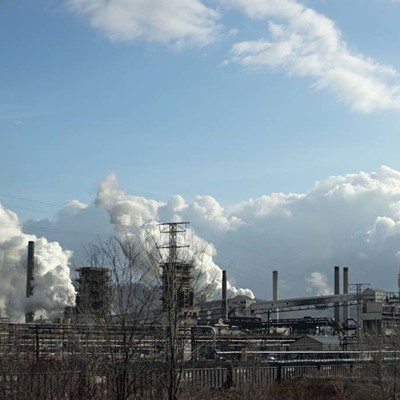It's something of a mystery: Levels of chemical compounds called bromides have been rising and falling in the Allegheny and Monongahela rivers and no one knows exactly why.
Wastewater from oil and gas drilling might be implicated, but in any case, further increases could spell trouble for the region's drinking water.
Bromides are salty compounds found in seawater — and in the briny residues of ancient oceans located deep underground where coal mines and oil and gas wells go. Bromides are nontoxic, but in drinking-water sources they're undesirable because they react, ironically enough, with the chlorine that treatment plants use as a disinfectant. Byproducts include trihalomethanes, a class of chemicals including carcinogens, and conventional drinking-water treatment eliminates neither bromides nor THMs.
Bromides weren't a problem here until mid-2010, when levels spiked in both rivers, and the Pittsburgh Water & Sewer Authority detected elevated THM in its distribution system. (Concentrations remained under federal limits.)
The rise coincided with increased Marcellus Shale gas-drilling activity. Drillers were carting millions of gallons of briny wastewater to sewage plants, where "treatment" consisted of slowly dumping it into local streams. The THM spike worried PWSA, which recruited the University of Pittsburgh's engineering school to help study the problem. Researchers began sampling river water daily at PWSA's intake (near Waterworks Mall) and monthly at 42 other sites in the Allegheny watershed.
In May 2011, the state Department of Environmental Protection got drillers to agree to voluntarily stop taking their waste to any treatment facilities, including sewage plants, that didn't operate under brine-discharge limits. This seemed to help at first, as bromide concentrations in both rivers dropped. (Another possible reason was a downturn in drilling activity due to low gas prices.)
In the Mon, bromide has since returned to 2009 levels, says Jeanne VanBriessen, the Carnegie Mellon University engineering professor who directs the Center for Water Quality in Urban Environmental Systems. But on the Allegheny, bromide rose again; Leonard Casson, a Pitt engineering professor, says it's back to 2010's highs.
What happened? Bromide sources include drainage from the region's countless abandoned coal mines, plus small amounts from steel mills and coal-fired power plants. But PWSA's research (which Casson presented Nov. 9, at Pitt's annual Health Effects of Shale Gas Extraction conference) suggests that currently, up to half the bromides are coming from a handful of industrial wastewater-treatment plants in the Allegheny watershed whose chief customers are oil and gas drillers.
"We sampled upstream and we sampled downstream, and oh, my gosh, there's a big contribution," says Casson. In one instance, downstream bromide levels were 18 times higher.
Thanks to the voluntary ban, such facilities are no longer receiving Marcellus wastewater, says DEP spokesman Kevin Sunday, in an email. However, they can still receive brine from conventional drilling. DEP regulates all discharges of treated wastewater. (Notably, there are no brine-treatment facilities in the Mon watershed.) "We are actively studying bromide levels in the Allegheny River basin in order to determine if further reductions are necessary," writes Sunday.
Environmental advocates and researchers alike say reductions are needed. "If you're going to use river water as your drinking water, you shouldn't discharge bromide," says VanBriessen.
Disposal options for brine are limited. According to the nonprofit Pittsburgh-based group Fractracker, for example, in the final six months of 2011, Pennsylvania produced 4.5 million barrels of drilling brine. About half was reused in fracking operations, an increasingly popular method for Marcellus operations. One quarter was sent to treatment plants. And one quarter was sent to deep-injection wells, many of them in Ohio. Injection is also the favored disposal method in most shale-gas-producing states. But Pennsylvania mostly lacks the necessary underground rock formations. (Moreover, two years ago, researchers say, deep-injection wells were the cause of rare earthquakes in Youngstown.)
Meanwhile, anticipating continued high bromide levels, PWSA is testing new equipment designed to remove THMs from drinking water.
"It's not really fair that PWSA customers are having to pay for [discharges] upriver," says Casson.
Smaller water authorities will have trouble affording such improvements, he adds: "My concern is this may cause a public-health problem for drinking water."
Next, PWSA and Pitt will seek to pinpoint the bromide's source. "Whatever it is," says Casson, "it's got to stop."














